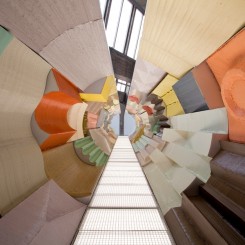Li Songsong solo exhibition.
Pace Beijing (798 Art Factory, 4 Jiuxianqiao Road, Chaoyang, Beijing). Sept 1 – Nov 22, 2012.
It is best to visit Li Songsong’s current exhibition in the early evening; as the day’s light evaporates from the gallery, the illuminated floor of the installation take precedence, its white glow glancing off the painted geometric protrusions lining a long walk-through-work stretching through the otherwise empty space. It is striking, indeed – day or night.
A guard mans the entrance to the capsule/catwalk, and only one visitor is allowed to pass through it at a time. Evading (in commonplace style) any prescription of interpretation, with no title and no text, the artist simply wants each to encounter this work for themselves. Pace, with its expansive Bauhaus space in Beijing, is faced always with a difficult dilemma: how to fill it. The obvious – although more risky – option is to place a large, authoritative art work in the middle and allow all attention to gravitate towards it. Thus are visits to the gallery frequently singular experiences, wherein one stand-alone idea makes its attempt. This is one such work.
The qualities of being visually or conceptually striking are different; sometimes (and most satisfyingly) they combine, but not infrequently one has the sensation of one without the other, or of their failure to fuse together. This installation seems to want to explode the single plane of the canvas, transmogrifying it into a somewhat sci-fi jigsaw in which 3D chunks fit together to encase the viewer – for a few moments enveloping them and blocking out the surroundings. Thus does one have the impression of a formal concept born of the ordinary physicality of a painting, married with an immersive manner of viewing it from “inside” the structure. Of course, there are commercial practicalities to which the work is not immune: the installation conveniently disassembles into 91 chunks priced at USD 50,000 each and which can be hung on the wall (like a normal painting). Beyond mere anecdote, this fact underlines the dual role of a gallery as a site dealing not only in the desire for purchasable works, but also for experiences; in China, where institutional leadership in creating memorable experiences of art is comparatively scarce, commercial galleries have come largely to address both requirements.
Li Songsong’s installation, one might say, tries neatly to satisfy concept, “look” and saleability in one fell swoop of an installation. It is difficult to avoid a sardonic analogy with an ornate cake that can be sliced up to please those who want personally to consume a slice; the question, finally, is whether one can truly have this cake and eat it, or not.
